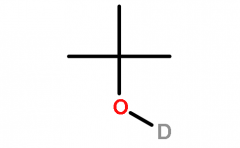C4H9DO

避光,通风干燥处,密封保存
常温常压下稳定,透明液体
避光,通风干燥处,密封保存
常温常压下稳定,透明液体
该物质对环境可能有危害,对水体应给予特别注意
| Name: | Tert.-butan(ol-d) 98+ atom % d Material Safety Data Sheet |
| Synonym: | NoneNon |
| CAS: | 3972-25-6 |
| CAS# | Chemical Name | content | EINECS# |
| 3972-25-6 | tert-Butan(ol-d) | 223-597-1 |
1.疏水参数计算参考值(XlogP):0.5
2.氢键供体数量:1
3.氢键受体数量:1
4.可旋转化学键数量:0
5.互变异构体数量:无
6.拓扑分子极性表面积20.2
7.重原子数量:5
8.表面电荷:0
9.复杂度:25.1
10.同位素原子数量:1
11.确定原子立构中心数量:0
12.不确定原子立构中心数量:0
13.确定化学键立构中心数量:0
14.不确定化学键立构中心数量:0
15.共价键单元数量:1